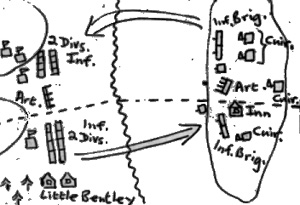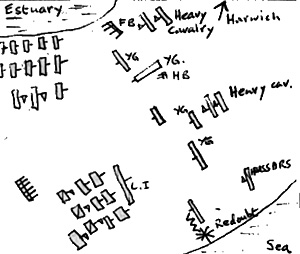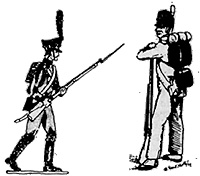(A campaign game played by the Mid-Herts Group; for strategic rules see June "Neweletter" basic numerical representation - one figure 40 men, one gun = a battery of 6).
General situation prior to the Fast Coast landings
French strategy during the first 10 days or so of the campaign was based on the natural assumption that the English would concentrate most of their forces (about 26,000 regular infantry, 4,800 cavalry, 90 guns) in the London area or within easy reach. In fact the English had decided to divide their regulars into four small equal armies: one in the South-West, one near Portsmouth, one near London, one in reserve near Reading and to employ a strategy ~of immediate counter-attack on all landings. In this way it was hoped to keep the French well away from the key naval bases, and prevent them from building up overwhelming strength in any one region.
The French, with far more regulars available, about 34,000 Line, 4,800 Young Guard and 6,000 cavalry, but limited in shipping, consequently found it difficult to obtain any foothold at first. They landed in small scattered groups which were easily dealt with. Their general plan, to create multiple diversions in the West and Wales and then land in East Anglia with the elite troops, largely failed at first, as the English had massed their militia regiments (one per county) within two or three days of the first May 1st landings into small local reserve armies of about four regiments each. These, appearing unexpectedly from directions different from the English regular armies, bewildered the French strategists as to the English strategic intentions.
For a long time, the French were seldom able to hold an area long enough to raise regiments of Republican sympathisers. It needed about 48 hours in undisputed control of the greater part of a county to muster and equip one such unit.
 French Landing on the East Coast, May 10th and 12th
French Landing on the East Coast, May 10th and 12th
The second stage of the French invasion began on the 10th with four ships landing a regiment of infantry (960 men) with supporting cavalry and field guns, at Lowestoft. The British reacted at first by sending a reserve army of regulars from Cambridge towards the invasion, and a mixed militia-regular army started out from London, hoping to meet the invaders or any others before Ipswich.
The Lowestoft landing was in fact only a bait, as on the morning of May 12th 4,800 Young Guard supported by 1,600 heavy cavalry and some guns and Line infantry landed at Harwich, and proceeded to march on Colchester next day. The Cambridge army was slightly delayed in reacting, owing to starting for Lowestoft, but the London army, coming leisurely up the main road, had plenty time to change its plan, swung right at Colchester, and deployed to check the Young Guard until the Cambridge force could come down to assist.
The French, about 5,700 infantry with 1,600 cavalry, deployed just East of where a brook crossed the Harwich-Colchester road near Little Bentley. The ground was featureless apart from a slight ridge on either side of the brook. Here the French were attacked by the London army of about 7,000 regulars and 6,000 militia!
Gambling on the militia not standing up to determined bayonet charges, (Militia throw 2 dice for morale when charged, need 5 or 6, choosing highest dice thrown. Line throw 3 dice, Elite troops 4. 1 dice deducted for disorder per 25". loss, etc.), the French planned to hold the road area with half the army, sending the other half to attack the English left strongly. Unfortunately the English had most of their regular rifles on this wing, and much energy and manpower had to be expended on simply destroying that one unit. The French advanced half a mile, the English masses falling back as the militia failed to stand when charged by the French cavalry. The English brought over a regiment of Guard infantry to stop the rot, and the French just hadn't the numbers to extend further. They began to withdraw across the brook towards 1-30 p.m. after 1.5 hours fighting (8 moves) With the satisfaction of having outshot the English Guard into routing temporarily, and swinging a cuirassier regiment left to ride down an English Line infantry unit near the Inn which had already been gutted by musketry from the Inn defenders. The English right wing had made good progress towards the French ridge, but then had most of their first line of militia regiments flattened and broken by the superior musketry of the French regulars. (For firing, throw one average dice per 9 front rank regulars or 12 militia or other second-grade troops).
The second line retired to the Little Bentley position to await the Cambridge army, having the satisfaction of halting the French advance on Colchester and London. The French, with only 1 infantry regiment still in good fighting trim, withdrew to Harwich to join with the Lowestoft column now crossing the estuary in small craft (evening of 13th).
Almost a third of the French were casualties after this bloodbath, whilst of the English only 8,100 out of the 13,000 were still with the colowrs at nightfall.
 Battle of Harwich, May 14th
Battle of Harwich, May 14th
The next morning the English, reinforced by the Cambridge army to nearly 16,000 strong, attacked at dawn to avoid excessive casualties in the approach to the French lines over the very open isthmus - open apart from a few sandpits affording slight cover.
The French, amounting to about 9,000 but of which 2,000 were cavalry, had planned to tempt the English into an attack on the south-east sector, whereupon the French right wing would have swung round and tried to drive the English towards the sea coast.
But due to subordinates' mistakes, the two Young Guard brigades were stationed nearer the centre than the plan had intended, and this confused French reactions when the English surprised them by instead attacking in great force along the estuary shore, straight for Harwich, with a subsidiary thrust at the centre. The massed French field guns for half an hour cut down masses of the leading English assault line, but it was obvious that the English were going to break through at the estuary unless something were done quickly to bring French infantry over from the seacoast side. The situation was serious, as the English had cleverly kept a gap clear between their two wings, and 36 cannon were firing with deadly accuracy down this lane.
The French ordered their own infantry to abandon the redoubt and the whole seacoast sector, and to march at full speed towards the French grand battery, one regiment going straight along the beach to Harwich. To cover this move, the French Hussars and two regiments of cuirassiers were thrown-in against the smaller English assault force. The Hussars routed and practically wiped out some heavy dragoons before being cut down or captured by three light cavalry units, one cuirassier regiment caught a Guard infantry unit in disorder just after an infantry melee and routed them with loss. The remaining cuirassier unit broke two English line infantry units and although it was in the end also swamped by English reserves, the English advance had been held up just long enough to allow a good deal of the French infantry to disengage.
The English main attack had meanwhile reached the French gun line, which succeeded in beating off only the first two waves, having to limber up to avoid being overrun by the 3rd and 4th English lines. On this sector the French used infantry to gain time, the 1st Voltigeurs having a whole battalion engulfed and captured in the process. The English brought up two heavy dragoon regiments and decided the day. They rushed the French horse batteries, which broke, and one went on to hit a fresh Young Guard regiment just arrived in disorder after a hurried march from the seacoast side. This did not break, but was too disordered to stop the cavalry, (units in disorder have only half the normal melee points value, So in this case 24 Young Guard at 1.25 points each = 30 points, fought 10 heavy dragoons at 5 points each = 50 points), and was driven back.
Covered by counter-charges by the cuirassier brigade supporting the guns, the French poured back in disorder to Harwich. The two horse batteries could not be recovered, and the 16th Line could not get back to the town through the throng of hostile cavalry and light infantry, bringing the total of prisoners taken by the English to 640 cavalry and 1,440 infantry.
Three cuirassier regiments and two Young Guard regiments still in a good fighting state took up position in the outskirts, and, together with the guns which had been rescued from the pursuing English, checked pursuit for a short time. The English guns were far to the rear.
At first the general in charge thought of digging in to try and hold Harwich, as a base near London, but further orders came in by frigate during the day with fuller information as to just how heavily he was outnumbered by the English armies defending London from the North, and ordering him to embark and abandon the port. The last companies of tirailleurs left the docks in the late afternoon, under fire from the converging English riflemen.
So the English, at the cost of not much more than 1,500 killed, had achieved a decisive victory, leaving their London army free to return to base. The French had been lucky in saving any of their army, against such odds.
More 1810 Invasion
Back to Table of Contents -- Wargamer's Newsletter # 101
To Wargamer's Newsletter List of Issues
To MagWeb Master Magazine List
© Copyright 1970 by Donald Featherstone.
This article appears in MagWeb.com (Magazine Web) on the Internet World Wide Web.
Other articles from military history and related magazines are available at http://www.magweb.com
